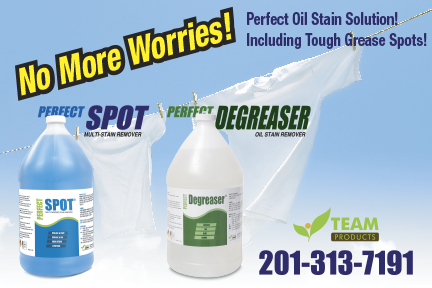The new protein formulas available have changed in many ways. The big change is the safety factor. Years ago removing a stain on a silk, wool and bright and vivid colors were a problem due to the ability of the alkali to bleed or change the color of the fabric. The protein formulas that are now used are very mildly alkaline so the safety factor has improved drastically. Cleaners can now use the protein formulas of most chemical companies with safety if used properly. Chemical companies do not formulate protein formulas with ammonia which is a more aggressive alkali that is capable of affecting dyes.
FACTS ABOUT ALKALI
- Alkalis are defined as chemicals that release hydroxyl ions in the presence of water. Alkalis are soluble in water and wetside chemicals.
- Alkalis will turn PH or litmus paper to blue.
- Used to neutralize acid.
- Used to restore color change caused by acid.
- Used with wetside synthetic detergents to increase soil removal.
- Stronger alkali should be tested on wool, silk and bright colors.
- Used for removal of protein stains, some red inks, dye and medicine stains.
- Used in prepared protein formulas.
- Used to accelerate hydrogen peroxide.

PROTEIN FORMULAS
- Usually a mild alkali that is safe for the dyes on wool and silk. If heat is applied the alkali will be activated decreasing the safety factor. On very bright and vivid colors testing is advisable.
- Very effective for neutralizing hydrofluoric acid or rust remover.
AMMONIA 26º
- Evaporation Characteristics-When ammonia is put on a fabric and left to evaporate it will not leave an alkaline residue on the fabric. It could however cause a color change which would need an acid to neutralize.
- Used for the removal of protein stains.
- Neutralizes color change caused by acids.
- Used for the removal of some inks, dyes and medicines.
- Effective for the removal of soil on spotting board or in wetcleaning.
- Will accelerate hydrogen peroxide.
- Should be tested on wools, silks and vivid colors.
- May set tannin stains.
PROTEIN PROCEDURE FOR WOOLS, SILKS AND COLORS
- Flush
- Neutral lubricant
- Mechanical action
- Flush
- Protein formula
- Mechanical action
- Flush but keep steam gun at a safe distance
- Hydrogen peroxide plus ammonia
- Heat
- Flush
- Acid
- Flush
PROTEIN PROCEDURE FOR LIGHT COLORED COTTONS, LINENS AND RAYONS
- Flush
- Neutral lubricant
- Mechanical action
- Flush
- Neutral lubricant plus ammonia
- Mechanical action
- Flush
- Peroxide plus ammonia (Test)
- Heat
- Flush
- Acid
- Flush

NEUTRALIZING ACID COLOR CHANGES
- Flush
- Apply ammonia
- Heat
- Flush
ALKALINE BASED BOOSTERS
There are several alkaline based products that act as boosters to enhance the wetcleaning process. Ammonia is not a good booster since it is highly alkaline and dissipates in the wetcleaning process. A booster will make the wetcleaning detergent more aggressive and accelerates the action of oxygen based bleaches. Some boosters also have characteristics of softening water. Boosters, being alkaline in nature neutralize fatty acids found in soil making cleaning more effective. A neutral PH is 7 and boosters have PH that run from 8 to 11.
(1) BAKING SODA (SODIUM BICARBANITE)
This has a PH of 8.1 and will effectively accelerate oxygen bleaches and make wetcleaning detergents more aggressive. The alkalinity is low so the acceleration is not too drastic.
(2) BORAX (SODIUM BORATE)
This has a PH of 9.5 and so this booster is more aggressive than baking soda. It also has a characteristic of being a water softener.
(3) WASHING SODA (SODIUM CARBONATE)
This is the most aggressive of the boosters since it has a PH of about 11.

Dan Eisen
Dan Eisen, former chief garment analyst for the National Cleaners Association, offers lecture, consultation and garment analysis service. He is the author of The Art of Spotting. He can be reached at (772) 340-0909, by email at cleandan@comcast.net or through his website at www.garmentanalysis.com. Dan Eisen, 274 NW Toscane Trail, Port Saint Lucie, FL 34986.
